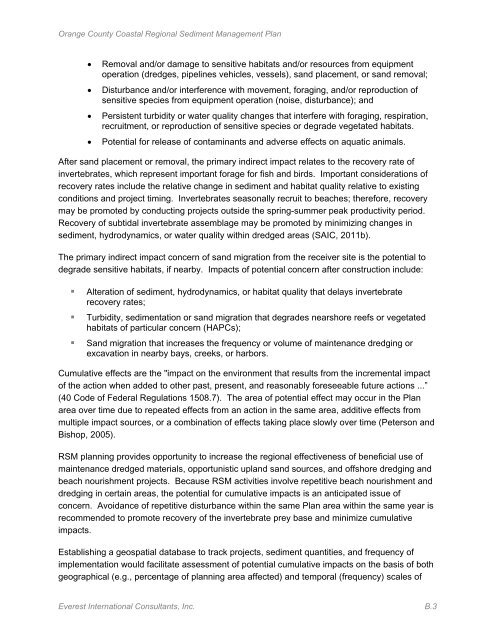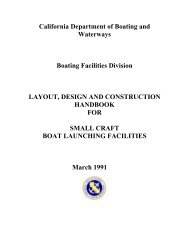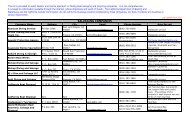EVEREST June, 2013 - California Department of Boating and ...
EVEREST June, 2013 - California Department of Boating and ...
EVEREST June, 2013 - California Department of Boating and ...
You also want an ePaper? Increase the reach of your titles
YUMPU automatically turns print PDFs into web optimized ePapers that Google loves.
Orange County Coastal Regional Sediment Management Plan<br />
• Removal <strong>and</strong>/or damage to sensitive habitats <strong>and</strong>/or resources from equipment<br />
operation (dredges, pipelines vehicles, vessels), s<strong>and</strong> placement, or s<strong>and</strong> removal;<br />
• Disturbance <strong>and</strong>/or interference with movement, foraging, <strong>and</strong>/or reproduction <strong>of</strong><br />
sensitive species from equipment operation (noise, disturbance); <strong>and</strong><br />
• Persistent turbidity or water quality changes that interfere with foraging, respiration,<br />
recruitment, or reproduction <strong>of</strong> sensitive species or degrade vegetated habitats.<br />
• Potential for release <strong>of</strong> contaminants <strong>and</strong> adverse effects on aquatic animals.<br />
After s<strong>and</strong> placement or removal, the primary indirect impact relates to the recovery rate <strong>of</strong><br />
invertebrates, which represent important forage for fish <strong>and</strong> birds. Important considerations <strong>of</strong><br />
recovery rates include the relative change in sediment <strong>and</strong> habitat quality relative to existing<br />
conditions <strong>and</strong> project timing. Invertebrates seasonally recruit to beaches; therefore, recovery<br />
may be promoted by conducting projects outside the spring-summer peak productivity period.<br />
Recovery <strong>of</strong> subtidal invertebrate assemblage may be promoted by minimizing changes in<br />
sediment, hydrodynamics, or water quality within dredged areas (SAIC, 2011b).<br />
The primary indirect impact concern <strong>of</strong> s<strong>and</strong> migration from the receiver site is the potential to<br />
degrade sensitive habitats, if nearby. Impacts <strong>of</strong> potential concern after construction include:<br />
• Alteration <strong>of</strong> sediment, hydrodynamics, or habitat quality that delays invertebrate<br />
recovery rates;<br />
• Turbidity, sedimentation or s<strong>and</strong> migration that degrades nearshore reefs or vegetated<br />
habitats <strong>of</strong> particular concern (HAPCs);<br />
• S<strong>and</strong> migration that increases the frequency or volume <strong>of</strong> maintenance dredging or<br />
excavation in nearby bays, creeks, or harbors.<br />
Cumulative effects are the "impact on the environment that results from the incremental impact<br />
<strong>of</strong> the action when added to other past, present, <strong>and</strong> reasonably foreseeable future actions ...”<br />
(40 Code <strong>of</strong> Federal Regulations 1508.7). The area <strong>of</strong> potential effect may occur in the Plan<br />
area over time due to repeated effects from an action in the same area, additive effects from<br />
multiple impact sources, or a combination <strong>of</strong> effects taking place slowly over time (Peterson <strong>and</strong><br />
Bishop, 2005).<br />
RSM planning provides opportunity to increase the regional effectiveness <strong>of</strong> beneficial use <strong>of</strong><br />
maintenance dredged materials, opportunistic upl<strong>and</strong> s<strong>and</strong> sources, <strong>and</strong> <strong>of</strong>fshore dredging <strong>and</strong><br />
beach nourishment projects. Because RSM activities involve repetitive beach nourishment <strong>and</strong><br />
dredging in certain areas, the potential for cumulative impacts is an anticipated issue <strong>of</strong><br />
concern. Avoidance <strong>of</strong> repetitive disturbance within the same Plan area within the same year is<br />
recommended to promote recovery <strong>of</strong> the invertebrate prey base <strong>and</strong> minimize cumulative<br />
impacts.<br />
Establishing a geospatial database to track projects, sediment quantities, <strong>and</strong> frequency <strong>of</strong><br />
implementation would facilitate assessment <strong>of</strong> potential cumulative impacts on the basis <strong>of</strong> both<br />
geographical (e.g., percentage <strong>of</strong> planning area affected) <strong>and</strong> temporal (frequency) scales <strong>of</strong><br />
Everest International Consultants, Inc. B.3




